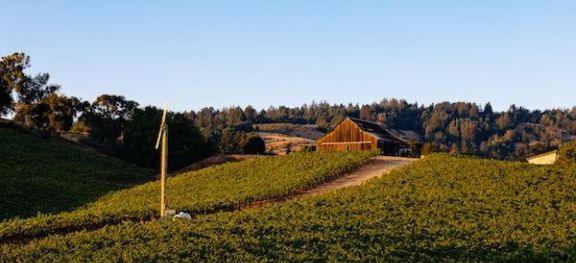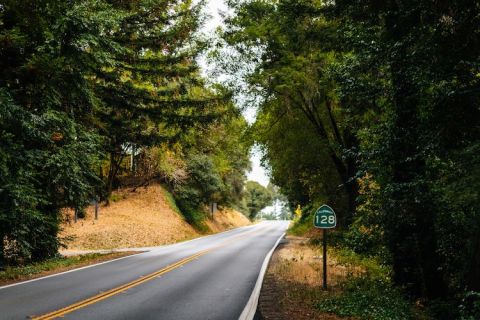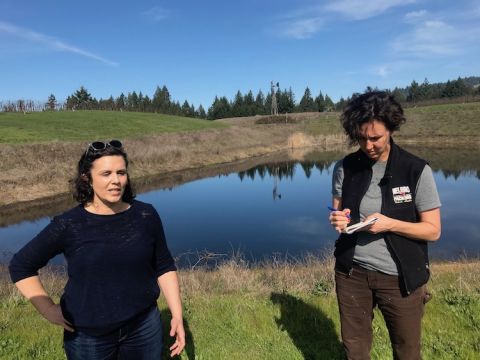Anderson Valley – not to be overlooked

A shorter version of this article is published by the Financial Times. See also Anderson Valley – the tasting notes.
How could one resist a wine district with its own dialect, Boontling, which, according to Wikipedia, is ‘now mostly spoken by aging counter-culturists’? Its northern limit is known locally as ‘the deep end’, one of its characteristic geologies is Bearwallow-Wolfey, and the district’s special, tiny, mint-scented flower whose perfume some pick up in its wines is called pennyroyal.
But it was not vocabulary that drew me to Anderson Valley in Mendocino county during a recent visit to northern California. It was the quality of its wines, especially its Pinot Noir. Pinot Noir is hugely fashionable in the US and trend-conscious producers, and consumers, have been seeking out the coolest (in both senses) California wine regions such as the Sonoma Coast in the north and Sta Rita Hills in Santa Barbara County in the south.
But Anderson Valley, while being decidedly cool – too cool to ripen grapes at all on some valley-floor sites – makes wines that have fragrant charm rather than austerity, and can be relatively reasonably priced. It also, as I found out on this recent trip, has a special hidden, homespun quality about it. It’s even further north than the fashionable newish vineyards of Sonoma Coast, from which it is just one coastal ridge away. Called after a family heavily involved in the mid nineteenth century in wresting California from Mexican control, the valley is narrow, heavily wooded and about 15 miles long. The only way in is via the two-lane Highway 128 that threads through its redwoods and apple orchards. Give or take a logging truck, Anderson Valley has a quietness about it and is very much off the beaten track. Its seclusion may well have encouraged the locals to develop their own language.
Entirely different from Napa Valley and even Sonoma in ethos, it provided hideouts for marijuana growers long before weed was legalised. Although over the years there had been small-scale experimentation in growing grape-based intoxicants, and Navarro have been making some of California’s finest Riesling and Gewurztraminer for years, it was when respected Champagne producer Louis Roederer decided in the early 1980s to make California sparkling wine in Anderson Valley that the district was put on the international wine map. (Fellow Champenois and Cava producers all chose sites much further south which have proved less resilient to climate change.)
In 1988 the operation responsible for the sales phenomenon that was and is Kendall-Jackson Vintners Reserve Chardonnay bought the pioneer Edmeades vineyard, and what is now Jackson Family Wines own three more quite significant vineyards in the valley, now called Maggy Hawk, Skycrest and Sable. Like all the best sites, they are well above the frost-prone valley floor but are cooled by the Pacific fogs that swirl in nightly from the ‘deep end’ over the coastal range from the ocean just four or five miles away. The fogs generally extend only so far southwards so elevation is even more important for southern vineyards, which need to be high enough to catch the afternoon ocean breeze.
Other high-profile incomers included Ted Lemon, whose Littorai Pinot Noirs – from Sonoma Coast and Anderson Valley – are now some of California’s most admired. A more recent, if controversial, compliment was the arrival of Rhys Vineyards, a producer that was initially established, without thought for the expense, in the Santa Cruz mountains above Silicon Valley by burgundy-loving venture capitalist Kevin Harvey. Rhys’s steep, west-facing vineyard is called Bearwallow, the wine from a particularly special plot within it Porcupine Hill.
Before taking over as winemaker at Rhys, Jeff Brinkman had previously worked in Anderson Valley and had been won over by the valley’s ability to produce wines with ‘that crunchy red fruit and a really pretty floral character’. Rhys is predicated on hillside vineyards and Brinkman was a particular fan of the varied elevations and fractured shale, quartz and sandstone soils of the Bearwallow site. Rhys are building a new winery nearby for Bearwallow and a new Italian project rather than having to truck their Mendocino grapes all the way south of San Francisco.
The northern deep end is the coolest, not because it’s further from the equator but because it’s closest to the Pacific. One of the northernmost vineyards is Jackson’s Maggy Hawk, lovingly tended by Sarah Wuethrich (seen below with our California specialist Elaine Chukan Brown, who toured Anderson Valley with me), who describes her most distant parcel of vines, the Bear Block, as ‘sacrificial’, so attractive is it to local wildlife, especially bears.
She has found the Anderson Valley grape-growing community ‘super tight knit’ although a current terroir study of the valley is exposing a certain rift between the younger producers, who see the development of official subregions as a celebration of the differences between various parts of the valley, and the oldtimers, who worry that developing subregions would be perceived as a qualitative ranking. A familiar conflict.
Mendocino is the general appellation here and is how most of the wines made in the wider, warmer valley to the east are sold, but on this last visit I found myself rather fascinated by the appellation to the immediate south of Anderson Valley, Yorkville Highlands, and, especially, by Mendocino Ridge, which is well to the west of most of Mendocino and lies between Anderson Valley and the chilly Pacific. Mendocino Ridge is known as ‘islands in the sky’ because it applies exclusively to land above 1,200 ft (365 m), so hills that are generally above the fog line but fully exposed to marine onslaughts. The Mariah Vineyard at 2,600 ft (790 m) is the second highest vineyard in California, yet is a stone’s throw from the ocean. A newish part-time operation Minus Tide has made some particularly promising wines from this and other Mendocino Ridge vineyards.
Yorkville Highlands was dismissed by one Anderson Valley grower as ‘a geological mishmash’ but I tasted some pretty inspiring Syrah grown here by a British couple who work in Silicon Valley during the week and tend their Halcón wines and vines at 2,500 feet on fashionable schist at weekends. They fell in love with Rhône wines on a trip there with British Rhône specialist wine writer John Livingstone Learmonth and are doing their best at emulation.
The recommendations on the previous below are based on a tasting of 21 Anderson Valley 2018 Pinot Noirs which are yet to be released. They all seemed to me quite ready to enjoy but they probably won’t reach even the US market until later this year. Whatever the vintage, I’d be confident in recommending virtually any Anderson Valley Pinot from Anthill Farms, Copain, Littorai and Rhys.
Mel Knox, veteran barrel salesman of San Francisco, adds: I've always been a big supporter because it is cool like Oregon but has more regularity to its harvests like California. In Oregon sometimes you get flowering at the end of June, which means October harvest during a rainy time. In the Anderson Valley flowering is a bit sooner and rain a bit later. Unlike Burgundy you don't need to fly 6,000 miles and learn a new language. Instead you have a few moments of curved road and if you can say Horn of Zeese [a 'horn' is a cup in Boontling and 'Zeese' was known for his strong coffee] the locals are nice.
Don't forget that Wild Boy [Jim Clendenen of Au Bon Climat] and I made wines from the Anderson Valley for 13 years and some of them are masterpieces. Indeed you made our 2002 Chardonnay wine of the week.
Some lovely Anderson Valley Pinot Noirs
with alcohol levels and recommended retail prices in the US
I scored these 17 out of 20
Anthill Farms 2018 13.3% $40
Drew, Morning Dew Ranch 2018 13% $70
Maggy Hawk, Jolie 2018 13.8% $65
I scored these 16.5 out of 20 (a high score for me)
Bravium, Wiley Vineyard 2018 13.1% $39
Copain, Abel 2018 12.9% $65
Hartford Court, Velvet Sisters 2018 14.1% $75
Husch 2018 13.9% $25
Long Meadow Ranch 2018 13.5% $42
Witching Stick, Dowser's Cuvée 2018 14% $42
Tasting notes in Anderson Valley – the tasting notes. Stockists via Wine-Searcher.com.
Become a member to view this article and thousands more!
- 15,430 featured articles
- 274,108 wine reviews
- Maps from The World Atlas of Wine, 8th edition (RRP £50)
- The Oxford Companion to Wine, 5th edition (RRP £50)
- Members’ forum
- 15,430 featured articles
- 274,108 wine reviews
- Maps from The World Atlas of Wine, 8th edition (RRP £50)
- The Oxford Companion to Wine, 5th edition (RRP £50)
- Members’ forum
- Commercial use of our Tasting Notes


